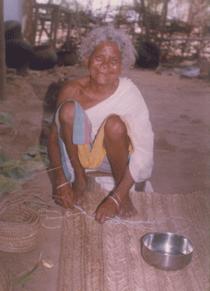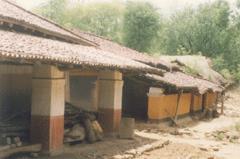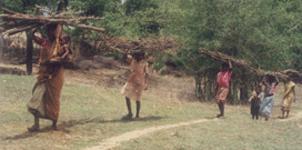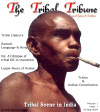Ho: A Glimpse of Tribal Life In Transition
Physically, the Ho belong to Australoid phenotype with short stature, thinly built body, dark brown skin, short and broad nose with dark-brown eyes. Scalp hair is deep brown, deep wavy often looking curly. Facial and body hair is scanty.
|
|
|
The Ho is very intimate with forest, where they feel secured. So most of their villages are inside or at periphery of forest. As forest coverage is now restricted to the hills (extended Eastern Ghats), the villages are generally at the foot hills, with water-sources. The villages are often divided into several hamlets with clusters of houses facing each other on either side of roads. This is mainly due to undulating nature of land. The open spaces in between hamlets are either used for cultivation or left to grow natural vegetation. The houses are built of mud and other locally available resources, like wood, straw (of paddy or other wild grasses) and ‘Khappra’ (semi-cylindrical burnt clay tiles). They decorated their houses with cow dung –mud plasters and soil /ochre colours and keep very clean size of the houses and number of rooms or area of covered place vary as per family capacity. Majority people make one large room and divide internally into several compartment for specific purposes like cooking, storing grains, sleeping etc. The ancestral spirits are believed to stay in the inner chamber where they are propitiated. |
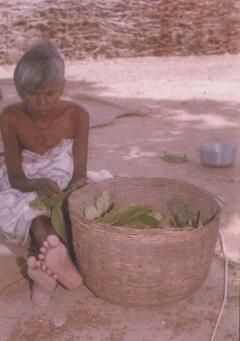 |
The Ho depends on rice as staple food and prepares home fermented rice-beer for daily consumption. Occasional hunting or sharing of small game animal or bird, provide protein. Beef and pork are not prohibited, but to be acceptable to the Hindu neighbors, they are now a days avoiding. Like all tribal people, the Ho are also very fond of intoxicating drink. Mahuli (liquor) is prepared from Mahua (Madhuca latifolia) flowers and enjoyed. Tobacco leaves chewed raw or puffed through hand made cigars (Picca or Bidi). There is no gender difference in smoking or drinking liquor. Along with paddy, they csultivate other millet also. Their agricultural tools are very simple. Ploughing is carried out using bullocks, wooden plough with iron shoe/ blade yoke, leveler, sickle etc.
|
Traditional male dress is a short striped cloth piece- ‘Botoi’. Covering the abdominal part and thigh, one end tucked up on backside. The traditional woman’s dress is short Sari (lagna or lagia), covering the torso and abdominal portion hanging just below the knees. Women don’t use any blouse or undergarment. But now men have started using pant, shirt, dhoti and lungi and women use longer sari, due to contact with advanced people. The younger school going children wear dresses prescribed by the school.
The Ho traditional dialect belongs to Munda branch of Austro Asiatic family of languages, allied to Santali and Mundari speakers of eastern and central India. Like the Turkish language, the Ho dialect is also known as agglunitive language, where the inflections have lost their meaning as separate entities by he process of ‘Phonetic decay’. The vocabulary of Ho is also very peculiar, where a number of words are used to indicate individual things and ideas but there are no such words used for general and abstract terms (Prasad, S. 1961).
At present, the Ho dialect is confined only when they speak among themselves. They speak a mixture of Ho and Hindi and use Hindi script in the Jharkhand area, speak a mixture of Ho, Hindi and Oriya and use Oriya script in Mayurbhanj (Orissa) and in Bengal, they use Bengali script and Ho, Hindi, Bengali mixed dialect when communicating with others. Vast majorities of To-day’s Ho people are multilingual. Language influence of other communities are so deep, that these people are now keeping the name of their children in Indo-Aryan names for formal identity and names in Ho for personal address. Thus Ramachandra, Ghanasyam, Durga, Janaki also have home names like Jaklo, Rode, Jhingi, Dumdi etc. The schoolteachers are also responsible for giving formal Sanskritc names. Besides this, Ho parents are sometimes impressed by some Oriya surnames viz. Mohanty, Rout etc and use these as first name along with Ho surname viz. Mohanty Deogam, Rout Deogam. Also some Indo-Aryan names like Lily or August (month name) etc are found. Often such unacquainted names are phonetically distorted when Laxman become Lokan, Geeta becomes Gite, Sita becomes Seete etc. In the nomenclature of villages also such admixture of Ho and other languages happened. For example, a village ‘Badhantnabeda’ is a combination of three words: ‘Bad’ (Oriya word meaning Big), ‘Hatna’ (in Kolhan ‘Hatna’ meaning ‘Arjun Tree’ or ‘Terminalia arjuna’) and Beda (in Kolhan means large cultivable land). Because the village was established by filling large number of ‘Arjun trees’ and was surrounded by low cultivable land, the name ‘Hatnabeda’ was given. Later on to avoid confusion with another synonym small village Oriya prefix ‘Bada’ was added. It is interesting to note how neighboring Hindus introduced change in Ho culture. The Ho erect on memorial stone pillar on the burial of a person after death which is known as ‘Sasandhiri. On this stone, the identity and achievement of the deceased is engraved. As there is no expert engraver among them and the Ho does not have any script of their own, they hire an engraver from Hindu neighbour. The engraver used his own script (Hindi or Oriya) to engrave the matter, but often engraved ‘Om Ganesaya Namoh’ as per Hindu practices. The Ho do not show resentment towards such accretion to their identification marker.
|
The census (1981) reveled that some Ho are Hindu or Christian or Muslim, Sikh etc. but 81.65% in Jharkhand, 81.49% in Orissa and 97.69% in West Bengal, follow their own religion. The nature worshipping Ho believe in ‘Sarna’ religion. The ‘Sarna’ is derived from ‘Sar’ meaning ‘Arrow’. As like other tribes of the area, the Ho area of worship is ‘Sarnasthal’ or ‘Jahera’, a small grove outside he village. It is believed that the sacred grove is remnant of old forestland, their ancestors cleared for settlement. The Ho gods have a blanket name ‘Bonga’ who are both power and spirits, some are benevolent and some malevolent. There are various types of ‘Bonga’ and ancestral spirit or ‘Bura Buri’. A look into the following chart may clarify. |
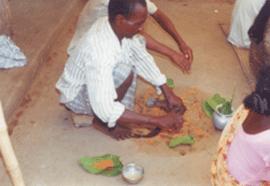 |
The Ho Bongas: Nature of Worship and Hindu Equivalence
| Name of the Bonga | Its nature and Place of Existence | Time of worship | Reason of Worship | Offerings and Sacrifices | Corresponding Name in Hindu Pantheon |
| Singh- Bonga | Supreme deity, Creator | Prior to every worship, but specially during maghe parab | Expression of devotedness | white sim (chicken) | Sun God |
| Marang Bonga* | Clan deity | Irregular interval | To protect respective clan/clans from disease, drought etc. | Sunned rice, sindoor (vermilion) and Areca Nut and sometimes a Boda (unsterilised He-Goat) | Mahadeva |
| Buru Bonga** (Buru means Hill) | The deity of hill responsible for different types of danger in forest/hills | Akhari Parab | To protect them from evil spirits, accidents and other sorts of danger in forest/hills | ||
| Bura Buri | Ancestor spirits | Sarhul Parab | |||
| Goram | Village Deity | Every month | To protect the village and its inhabitants | Sindoor, Rice, Flower and red sim | |
| Dessauli Bonga (Des means country/Place) | Village deity, Protector against diseases | Maghe Parab, Baha Parab, Haro Parab and Jomnawa Parab | To protect the villagers from small pox, cholera and other epidemics | Sarjom blossoms, red sim, merom, etc. | |
| Bagia Bonga** | The deity of tiger and other wild animals | Akhari Parab | To drive away hazards from forest/Hills | ||
| Nage Bonga | River Goddess (Supposed to be the wife of Sing Bonga) | To protect from the diseases of ear and hydrocele | Pig, egg, haldi (turmeric powder) | ||
| Gara Satamia** | Nai Bhagabati | ||||
| Suni kar** | Shani (Saturn) Kala | ||||
| Rahu Kar** | Rahu Kala | ||||
| Chandi** | Chandi/ Kali | ||||
| Juguni Bonga** | Juguni |
*According to some scholars the Marang Bonga and Buru Bonga are two different names of the same deity but as per the field information both are different from each other
**Malevolent Bongas
Majumdar (D.N) suggested that all the malevolent Bongas of Ho are not their own, but entered from the equivalent forces of neighbouring Hindu communities. For example ‘Gara satami’ of Ho has originated from Hindu Oriya deity ‘Nai Bhagwati’, presiding over ponds / tanks. ‘Satami’ is distorted form of ‘Sat-ma’ or stepmother who often becomes angry, but original mother ‘Nage – bonga’ or river goddess is kind. Simillarly from Hindu malevolent planetary powers like ‘Sani’ or ‘Rahu’, the Ho accepted ‘Suni-Kar’, ‘Rahu-Kar’ etc. Following Hindu ‘Chandi’ (strong woman power), Ho appease ‘Bisai – Chandi’ (Poison), ‘Ranga-Chandi’ (Red for Blood thirsty) , ‘Jugini’ and ‘Dakini’ etc. ,all from Hindu ‘Tantra’ cult. As they are essentially forest dweller, they have fear from snakes whose presiding deity ‘Manasa’ is worshiped following Hindu neighbours.
All the tribal communities have very strong believe in witchcraft, the Ho is no exception. The witch or ‘Dian’ (usually very old woman of the society) accrue evil power and do harm persons in many ways. The secret activities of witch ladies invocation of evil ‘Bonga’ at village cremation ground in dark new moon night (Amabasya). ‘Deonwa’ or witch doctor counters the witchcraft activities. These ‘Deonwas’ are from low –caste Hindu neighbours. It is to be noted that ailments or supernatural problems call for inter community cooperation.
Due to continuous interaction with neighboring Hindus (Jharkhand & Orissa) many Ho rituals have undergone changes.
Birth
A child is due to blessings of Singbonga. During gestation, the expectant mother is kept under various prohibitions in food, work and even using objects. A malevolent spirit ‘Churningbonga’ is appeased. Midwives now assist birth. The mother is kept under pollution restriction to take rest and prevent infection.
Name Giving
The Ho observe purification after 8 days, when the father and the baby are tonsured and ancestor spirits and clan members propitiated. Many Ho perform this on 21st day, following Oriya speaking neighbours. Shaving is performed by a Ho of another clan (Khili). A feast is arranged. They have a ritualistic process of determining suitability of a name.
Puberty
Attainment of the puberty girls (Kui) is marked by a social ritual. This is an initiation to womanhood. The village priest (Dehuri) conducts the propitiation of Singbonga (other rituals by society women) if the menarche starts on inauspicious days.
Marriage
The Ho call it ‘Andi’, which is settled between clans. Monogamy is generally practiced, but polygamy is not ruled out. Sorroral polygamy (marrying wife’s sister) is also accepted. The following are the types:
- Diku Andi: Negotiation marriage.
- Opertipi Andi: When the groom captures the bride for marriage.
- Rajikhusi Andi: When both plan and elope.
- Anader Andi: When bride enters groom’s house by own will.
- Gardijaumai Andi: The groom lives in the bride’s house after marriage.
- Badal Andi: The two families exchange their daughters
In tribal world the bride’s family enjoys upper hand and they receive wealth (cash / kind) from groom’s family. In negotiation marriage, very elaborate process is followed both for finalizing and actual marriage. In other cases a consensus is reached afterwards. In every auspicious occasion the Dehuri or priest is called for propitiating Singbonga. Many Hindu processes have now mixed with original Ho practices.
Death
|
The Ho traditional belief is that Singbonga assigns certain duties to all persons to be performed within a specific time. If it is not completed he/ she will reborn to complete that work. A person’s deed in previous life is counted in present life. Now the belief is changing. All the community members gather as soon they get the death news. They follow elaborate process of rituals at the courtyard and burial ground. Before burial in a wooden box the corps is bathed, given new clothes, anointed with sandal paste and vermilion lime and water with basil leaves sprinkled. For every thing there is detailed methods. Different types of mortuary rites are performed for different types of death. A monument stone / pillar (Sasandhari) is erected on the burial, depicting detail identity of the deceased. |
|
Ho observe different festivals centered around agricultural activities throughout the year:
- Maghi Parab: January- February
- Baha Parab: February – March
- Raja Parab: May- June
- Hero Parab: June- July
- Bahatanli Parab: July-August
- Jamnawa Parab: September – October
- Kakamontanri / Kalam Parab: December- January.
Photographs by the author

